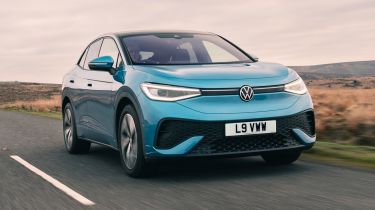Volkswagen ID.5 review - Range, charging & running costs
"Range figures for the ID.5 are reasonable, although some rivals will charge faster"
The factory that builds the Volkswagen ID.5 operates on renewable energy and Volkswagen offsets any ‘unavoidable’ carbon emissions, meaning the ID.5 is officially carbon neutral, so it’s off to a good start in terms of its eco-friendly credentials.
For a period of time the ID.5 was only available with the larger 77kWh battery, but as of late 2024 there’s also a 52kWh version like in the ID.4. This model, called Pure, can do up to 226 miles on a charge.
The larger 77kWh battery comes in the Pro models and can keep you going for up to 344 miles on a charge, but it does cost almost £6,000 more than the entry-level version. It’s worth considering this version if you want to do longer journeys, but if you only use your ID.5 for shorter trips around town, you could be better off with the smaller battery and the savings it brings.
The GTX returns up to 327 miles, but its battery will deplete much faster if you take advantage of its improved performance. It’s worth noting that these range figures have been massively improved since the ID.5 first launched – beforehand, the standard 77kWh model could achieve between 311 and 313 miles, while the GTX got a figure of up to 296 miles.
The ID.5 is capable of charging at speeds up to 145kW on the 52kWh battery model, and 135kW on the 77kWh model, resulting in a 10-80% top-up in as quick as 25 or 28 minutes, respectively. The GTX version gets the fastest charging speeds for its 79kWh battery, with up to 185kW speeds available, taking 26 minutes to go from 10-80%. That’s much less than the 350kW charging capability of the Hyundai Ioniq 5 and Kia EV6, but chargers this powerful are pretty much limited to various points on the motorway network.
A full charge at a home wallbox will take considerably longer, but plug in at teatime and the car should be fully charged by the morning.
Electric cars are unfortunately no longer exempt from VED (road tax), so you have to pay £10 for the first year and then the standard rate from the second year, currently set at £195. Because the ID.5 costs over £40,000, you’ll also have to pay the luxury car surcharge from years two to six of the car’s life. As with any electric car, business users stand to benefit from a minimal Benefit-in-Kind tax rate, which will slash your monthly tax bill if you’re coming from a conventionally-powered car.
Insurance groups
Insurance groups for the ID.5 have changed several times as the trim structure was updated and performance was increased, but it used to span from group 29 to 40 out of 50. For reference, the Ford Mustang Mach-E sits between groups 33 to 40 and the Kia EV6 sits in groups 33 to 45, so none of these models are particularly cheap to cover.
Warranty
UK buyers get a decidedly average three-year warranty with a 60,000-mile cap during that time. The BMW iX3 and Mercedes EQC offer the same length of cover but without a mileage limit, but all of those are overshadowed by the Kia’s seven-year warranty and the Toyota bZ4X’s 10-year warranty (both with 100,000-mile limits). The Tesla Model Y has a four-year, 50,000-mile warranty.
Servicing
You can buy a Volkswagen ID. service plan that covers a service, MoT, a brake fluid change and a new pollen filter for around £350 or 12 monthly payments of around £30.












